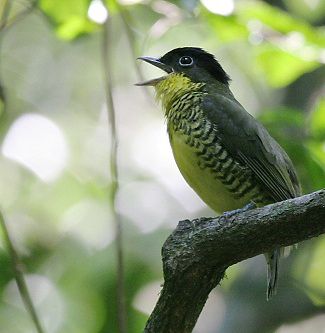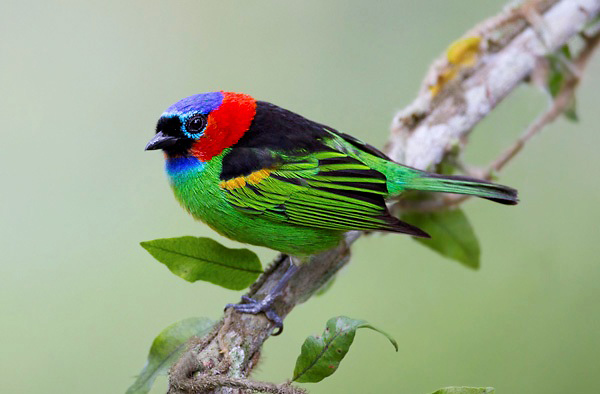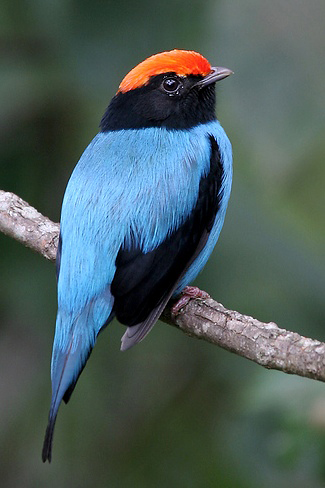

An Elegant Mourner, once known as Shrike-like Cotinga but no longer considered to be a cotinga by some taxonomists. This fine image of a singing male was captured at the Reserva Ecológica de Guapiaçu (REGUA) by one of its dedicated supporters Lee Dingain.
- There are more endemic birds in this corner of South America than anywhere else on the continent and although a lot of the 220 plus Atlantic Forest Endemics are localized, rare and little-known it is possible to see many of them on a month-long trip during the southern spring
- Including lots of cotingas and their close relatives such as Black-headed and Hooded Berryeaters, Cinnamon-vented Piha, Black-and-gold and Grey-winged Cotingas, Bare-throated Bellbird, Buff-throated Purpletuft and Elegant Mourner
- As well as Red-billed Curassow, Festive and Frilled Coquettes, Surucua Trogon, Rufous-capped Motmot, Three-toed Jacamar, Saffron and Spot-billed Toucanets, Red-breasted Toucan, lots of antbirds including some very large antshrikes, Black-cheeked Gnateater, Canebrake Groundcreeper, Black-capped Piprites, Pin-tailed Manakin, lots of tyrants and lots of tanagers including Brassy-breasted, Cherry-throated, Diademed, Gilt-edged, Golden-chevroned and Red-necked
- And other localised and spectacular species such as Scarlet Ibis, Red-legged Seriema, Giant Snipe, White-winged Potoo, Toco Toucan, Sharpbill, Red-ruffed Fruitcrow, Swallow-tailed Cotinga and Wing-barred Piprites
- With a few mammals including marmosets and monkeys

Red-necked Tanager at Ubatuba by Dubi Shapiro.
- The coastal plain of Brazil was once almost completely covered in tall, luxuriant rainforest called Atlantic Forest and known today as the Atlantic Forest Lowlands Endemic Bird Area (EBA), a biome which also reaches adjacent eastern Paraguay and northern Misiones Province in Argentina, and supports about 930 bird species including over 220 endemics. Today many of these species cling on in less than 5% (many say less than 2%) of the original forest cover, and this is in a highly fragmented condition. These bits of forest in the states of Espirito Santo, Parana, Rio de Janeiro and Sao Paulo support many of the rarest birds on the continent and some of the most critically endangered on Earth.
- Sites inland within striking distance of the mainly coastal sites discussed below, given sufficient time, include: Lapinha da Serra (Serra do Cipo) near Belo Horizonte north of Rio where it is possible to see Horned Sungem, Hyacinth Visorbearer, Long-tailed Cinclodes, Cipo Canastero, Marsh and Rock Tapaculos, Grey-backed Tachuri, Cinereous Warbling-finch, and Blue and Serra Finches; the Blue-eyed Ground-dove Reserve on the Monte Claros-Botumirim Road east of the Lapa Grande area where Dry Forest Sabrewing, White-throated Woodcreeper, Reisler’s Tyrannulet, Caatinga Black-tyrant and Francisco Sparrow occur, as well as Sooty-fronted Spinetail, Wager’s Woodcreeper, Black-bellied Antwren, Rufous Gnateater, Minas Gerais Tyrannulet and Red-crested Finch; the Serra da Canastra to the west where the very rare Brazilian Merganser lives, as well as Greater Rhea, Red-winged Tinamou, Spotted Nothura, Campo Miner, Collared Crescentchest, Brasilia Tapaculo, Cock-tailed Tyrant, Sharp-tailed Grass-tyrant, Helmeted Manakin, Ochre-breasted Pipit and Black-masked Finch; Campos do Jordao between Serra da Canastra and Ubatuba, which supports Vinaceous-breasted Amazon, Pileated Parrot, Araucaria Tit-spinetail, Black-capped Piprites and Golden-winged Cacique; Pousada Oikos where it is possible to see Buff-fronted Owl; and, finally, the Caraça Sanctuary, famous for the Maned Wolves which have been coming to scraps of meat left out for them at night since 1982. Birds which can be seen in the sanctuary and surrounding area include Hyacinth Visorbearer, Rock and White-breasted Tapaculos, Shear-tailed Grey-tyrant, Hangnest Tody-tyrant, Grey-backed Tachuri, Flavescent Warbler and Ultramarine Grosbeak.
- Farther south via a short flight, off the beaten track in the state of Rio Grande do Sul out of the capital Porto Alegre and Sao Francisco de Paula it is possible to see a wide range of different mainly wetland and open country birds, including Greater Rhea, Southern Screamer, Chilean Flamingo, Rufous-sided Crake, Giant Wood-rail, South American Painted-snipe (Lagoa do Peixe National Park near Mostardas), Snowy-crowned Tern (Lagoa do Peixe NP), Blue-bellied, Red-spectacled and Vinaceous Parrots, Long-tufted Screech-owl, Mottled Piculet, Olive Spinetail, Bay-capped Wren-spinetail (Lagoa do Peixe NP), Araucaria and Striolated Tit-spinetails, Sharp-billed Treehunter, Hudson’s Canastero (Lagoa do Peixe NP), Rufous Gnateater, Crested Doradito (Tramandai), Spectacled Tyrant, White Monjita, Many-coloured Rush-tyrant, an undescribed species of Speckle-breasted Antpitta, Eastern Slaty Thrush, Chestnut-backed Tanager and Green-throated Euphonia.
- If more time is available it is possible to link a trip to Southeast Brazil with a visit to Iguazu Falls. These falls on the border with Argentina may not be the highest in the world, at up to 82 m (269 ft), compared to Victoria Falls at 108 m (360 ft) for example, but they do tumble, in what is a series of waterfalls, over a crescent-shaped cliff about 2.7 km (1.7 miles) long, much longer than Victoria Falls at 1.7 km (1.1 miles). They are usually at their best during the wet season which lasts from November to March, especially in December, and have even been known to run dry in May and June during the dry season. There are some good birds too, including Black-fronted Piping-guan, Red-breasted and Toco Toucans, Spot-billed Toucanet, Great Dusky Swift, Black Jacobin, Surucua Trogon, Rufous-capped Motmot, Rusty-breasted Nunlet, Blond-crested Woodpecker, Rufous Gnateater, Southern Antpipit, Black-collared Swallow, Sharpbill, Band-tailed, Blue and White-bearded Manakins, and Green-headed Tanager, with a chance of Plush-crested Jay and Red-ruffed Fruitcrow.
Best Birds and other wildlife in Southeast Brazil
Birds
Endemics
East 62 Yellow-legged Tinamou, East Brazilian Chachalaca, Hooded Visorbearer, Sombre Hummingbird, Long-tailed Woodnymph, Little Wood-rail, White-necked Hawk, Atlantic Black-breasted (Ringed) Woodpecker, Golden-tailed Parrotlet, Plain Parakeet, Blue-bellied Parrot, Blue-breasted Parrot, White-eared Parakeet, Golden-capped Parakeet, Narrow-billed Antwren, Sincora Antwren (tiny range), Silvery-flanked Antwren, Salvadori’s Antwren, Band-tailed Antwren, Spot-breasted Antvireo (also recorded in extreme northern Argentina), Plumbeous Antvireo, Bahia Antwren, Sooretama Slaty Antshrike, Ochre-rumped Antbird, Scaled Antbird, Scalloped Antbird, White-bibbed Antbird, Squamate Antbird, Slender Antbird, Black-cheeked Gnateater, White-breasted Tapaculo, Bahia Tapaculo (tiny range), Boa Nova Tapaculo (tiny range), Diamantina Tapaculo (inland), Scaled Woodcreeper, Large Pale-browed Treehunter, Pink-legged Graveteiro, Striated Softtail, Bahia Spinetail, Wied’s Tyrant-manakin, Kinglet (Eastern Striped) Manakin, Black-headed Berryeater, Cinnamon-vented Piha, Banded Cotinga, White-winged Cotinga, Bahia Tyrannulet, Minas Gerais Tyrannulet, Oustalet’s Tyrannulet, Hangnest Tody-tyrant, Fork-tailed Tody-tyrant, Grey-hooded Attila, Sao Francisco Sparrow, Forbes’s Blackbird, Pale-throated Pampa-finch, Rufous-headed Tanager, Brazilian Tanager, Dubois’s Seedeater, Tropeiro Seedeater, Black-bellied Seedeater, Gilt-edged Tanager, White-bellied (Turquoise) Tanager and Silver-breasted (Opal-rumped) Tanager.
(Stresemann’s Bristlefront may be extinct. A survey in 1995 found 15 birds in an area the species was thought to exist in, in Bahia state, but during an extensive search in 2018 just a single female was found and up to October 2019 that remained the case)
Southeast 74 (13 antbirds, three cotingas and seven tanagers) Dwarf Tinamou, Scaled Chachalaca, Red-billed Curassow, Saw-billed Hermit, Hook-billed Hermit, Dusky-throated Hermit, Minute Hermit, Hyacinth Visorbearer, Festive Coquette, Brazilian Ruby, Green-crowned Plovercrest, Dry-forest (Grey-breasted) Sabrewing, Northern Surucua Trogon, Three-toed Jacamar, Greater Crescent-chested Puffbird, Yellow-eared Woodpecker, Brown-backed Parrotlet, Red-spectacled Amazon, Red-browed Amazon, Red-tailed Amazon, Ochre-marked Parakeet, Black-hooded Antwren, Serra Antwren, Restinga Antwren, Parana Antwren, Marsh Antwren, Rio de Janeiro Antwren, Unicoloured Antwren, Star-throated Antwren, Rufous-backed Antvireo, Rio de Janeiro Antbird, Ferruginous Antbird, Rufous-tailed Antbird, Fringe-backed Fire-eye, Slaty Bristlefront, Mouse-coloured Tapaculo, Rock Tapaculo, Marsh Tapaculo, Cryptic Antthrush, Long-tailed Cinclodes, White-collared Foliage-gleaner, Small Pale-browed Treehunter, Striolated Tit-spinetail, Orange-eyed Thornbird, Cipo Canastero, Itatiaia Spinetail, Pallid Spinetail, Serro do Mar Tyrant-manakin, Pin-tailed Manakin, Hooded Berryeater, Black-and-gold Cotinga, Grey-winged Cotinga, Atlantic Royal Flycatcher, Buff-throated Purpletuft, Elegant Mourner, Restinga Tyrannulet, Serra do Mar Tyrannulet, Eye-ringed Tody-tyrant, Kaempfer’s Tody-tyrant, Yellow-lored Tody-flycatcher, Grey-capped Tyrannulet, Rio de Janeiro Greenlet, Rufous-brown Solitaire, Half-collared Sparrow, Olive-green Tanager, Brown Tanager, Cherry-throated Tanager (rare), Black-legged Dacnis, Bay-chested Warbling-finch, Buff-breasted (Buff-throated) Warbling-finch, Azure-shouldered Tanager, Golden-chevroned Tanager, Black-backed Tanager and Brassy-breasted Tanager.
Near-endemics
Brazil and Argentina 9 Brazilian Merganser, Long-trained Nightjar, White-bearded Antshrike, Spotted Bamboowren, Planalto Tapaculo, Rufous-tailed Antthrush, Black-capped Piprites, Brown-breasted Bamboo-tyrant and Thick-billed Saltator.
Brazil, Argentina and Uruguay 12 Dot-winged Crake, Olrog’s Gull, Long-tufted Screech-owl, Curve-billed Reedhaunter, Freckle-breasted Thornbird, Hudson’s Canastero, Straight-billed Reedhaunter, Sulphur-bearded Spinetail, Bay-capped Wren-spinetail, Fork-tailed (Puna) Pipit, Brown-and-yellow Marshbird and Yellow Cardinal.
Brazil and Uruguay 1 Orange-breasted Thornbird.
Brazil, Paraguay and Argentina 76 Solitary Tinamou, Spot-winged Wood-quail, Purple-winged Ground-dove, Sooty Swift, Biscutate Swift, Scale-throated Hermit, Violet-crowned Plovercrest, Slaty-breasted Wood-rail, Black-capped Screech-owl, Tawny-browed Owl, Rusty-barred Owl, Southern Surucua Trogon, Rufous-capped Motmot, Buff-bellied Puffbird, Red-breasted Toucan, Spot-billed Toucanet, Saffron Toucanet, Ochre-collared Piculet, Robust Woodpecker, Blond-crested Woodpecker, Helmeted Woodpecker, Yellow-fronted Woodpecker, Vinaceous-breasted Amazon, Streak-capped Antwren, Southern Rufous-winged Antwren, Spot-backed Antshrike, Tufted Antshrike, Bertoni’s Antbird, Dusky-tailed Antbird, White-shouldered Fire-eye, Speckle-breasted Antpitta, Rufous-breasted Leaftosser, Plain-winged Woodcreeper, Planalto Woodcreeper, White-throated Woodcreeper, Lesser Woodcreeper, Black-billed Scythebill, White-throated Xenops, Black-capped Foliage-gleaner, White-browed Foliage-gleaner, Ochre-breasted Foliage-gleaner, Canebrake Groundcreeper, White-eyed Foliage-gleaner, Araucaria Tit-spinetail, Olive Spinetail, Rufous-capped Spinetail, Blue (Swallow-tailed) Manakin, Swallow-tailed Cotinga, Bare-throated Bellbird, Greenish Schiffornis, Russet-winged Spadebill, Sao Paulo Tyrannulet, Bay-ringed Tyrannulet, Southern Bristle-tyrant, Grey-hooded Flycatcher, Eared Pygmy-tyrant, Drab-breasted Bamboo-tyrant, Greenish Tyrannulet, Dinelli’s Doradito, Sibilant Sirystes, Shear-tailed Grey Tyrant, Rufous-crowned Greenlet, Creamy-bellied Gnatcatcher, Eastern Slaty Thrush, Green-throated Euphonia, Chestnut-bellied Euphonia, Southern Riverbank Warbler, Blackish-blue Seedeater, Black-throated Grosbeak, Ruby-crowned Tanager, Temminck’s Seedeater, Buffy-fronted Seedeater, Chestnut-headed Tanager, Uniform Finch, Green-headed Tanager and Red-necked Tanager.
Brazil, Paraguay, Argentina and Bolivia 8 Black-fronted Piping-guan, Great Dusky Swift, Pale-crested Woodpecker, Nanday Parakeet, Planalto Elaenia, Saffron-billed Sparrow, Ibera Seedeater and Stripe-bellied (Burnished-buff) Tanager.
Brazil, Paraguay, Argentina and Uruguay 33 Black Jacobin, Violet-capped Woodnymph, White-throated Hummingbird, Red-and-white Crake, Mottled Piculet, Yellow-browed (White-browed) Woodpecker, White-spotted Woodpecker, Maroon-bellied Parakeet, Large-tailed Antshrike, Rufous Gnateater, Scalloped Woodcreeper, Sharp-billed Treehunter, Grey-bellied Spinetail, Spix’s Spinetail, Brazilian (Small-headed) Elaenia, Olivaceous Elaenia, Warbling Doradito, Blue-billed Black-tyrant, Black-and-white Monjita, Azure Jay, Ochre-breasted Pipit, Yellow-rumped Marshbird, Saffron-cowled Blackbird, White-rimmed Warbler, Glaucous-blue Grosbeak, Lesser Grass-finch, Chestnut Seedeater, Marsh Seedeater, Black-and-rufous Warbling-finch, Grey-breasted Warbling-finch, Black-capped Warbling-finch, Diademed Tanager and Chestnut-backed Tanager.
Other specialities Rufous-sided Crake, Giant Snipe, Sickle-winged Nightjar, Ocellated Poorwill, White-winged Potoo, Red-legged Seriema, Giant Antshrike, Variegated Antpitta, Red-ruffed Fruitcrow and Wing-barred Piprites. Also a chance of Helmeted Woodpecker.
Others
Masked Duck, Scarlet Ibis, Swallow-tailed Kite, Blackish Rail, hummingbirds, Rufous-tailed Jacamar, Toco Toucan, woodpeckers, antbirds, Sharp-tailed
Streamcreeper, Streamer-tailed Tyrant, Screaming Piha, Sharpbill, Red-headed, White-bearded and White-crowned Manakins, and tanagers.
Mammals
Big-eared and Common Opossums, Common and Tufted-ear (Geoffroy’s/White-headed endemic geoffroyi) Marmosets, Black-fronted and Masked (endemic
Atlantic) Titi Monkeys, Brown (Black-capped/Black-(Tufted)) Capuchin, Brown-throated Three-toed Sloth, Guiana Dolphin, Nine-banded Armadillo, Capybara,
Collared Peccary, Lowland Paca, Brown Agouti, Pampas Fox, South American Coati and Red Brocket Deer. Also a chance of Brown Howler Monkey and Maned Sloth
(Santa Maria de Jetibá Northern Muriqui Reserve).
Best Sites for Birds and other wildlife in Southeast Brazil
- Vitoria-Santa Teresa-Linhares region, northeast of Rio
- Cafundo Private Reserve, near Cachoeiro do Itapemirim, Espirito Santo Plumbeous Antvireo, Eye-ringed Tody-tyrant and Wied’s Tyrant-manakin, as well as Red-browed Parrot, Blue-winged Macaw, Campo Flicker, White Woodpecker, Streamer-tailed Tyrant, seedeaters and Brown Howler Monkey.
- Private FRs near Venda Nova do Immigrante, Espirito Santo A chance of Cherry-throated Tanager (at Caetés Forest for example), as well as Pileated Parrot, Spot-billed Toucanet, Black-billed Scythebill, Giant Antshrike, Sharpbill, Cinnamon-vented Piha, Elegant Mourner, Bare-throated Bellbird, Blue and Pin-tailed Manakins, and Gilt-edged Tanager. Also a chance of Spot-winged Wood-quail, Long-trained Nightjar and Swallow-tailed Cotinga.
- Santa Teresa area including Mata da Penha forest patch, Augusto Ruschi Reserve, Museu Melo feeders and Pousada Vita Verde feeders many hummingbird feeders and hummingbirds including Frilled Coquette, Dusky-throated Hermit and Black Jacobin, as well as Spot-backed Antshrike, White-bibbed Antbird and Wied’s Tyrant-manakin (all three at Mata da Penha).
- Augusto Ruschi Marine Biological Station, on the coast of Aracruz feeders which attract numerous hummingbirds including Minute Hermit.
- Linhares VALE Natural Reserve, Espirito Santo Solitary Tinamou, Red-billed Curassow, White-necked Hawk, Red-browed Parrot, Ochre-marked and White-eared Parakeets, East Brazilian Pygmy-owl, Tawny-browed Owl, Ocellated Poorwill, Minute Hermit, Ringed Woodpecker, Sooretama Slaty Antshrike, Black-headed Berryeater, White-winged Cotinga, Red-headed Manakin and Cocoa Thrush, as well as Tufted-ear Marmoset and Brown Capuchin. Also a chance of White-winged Potoo, and an outside chance of Harpy Eagle and Banded Cotinga.
- CAETES Forest Cherry-throated Tanager, as well as Golden-tailed Parrotlet, Spot-billed Toucanet, Black-billed Scythebill, White-bibbed Antbird, White-shouldered Fire-eye, Spotted Bamboowren, Mouse-colored Tapaculo, Greenish and Oustalet's Tyrannulets, Drab-breasted Bamboo-tyrant, Sibilant Sirystes, Hooded Berryeater, Cinnamon-vented Piha, Sharpbill, Blackish-blue Seedeater and Uniform Finch.
- Cantinho Tres Pontoes Serra Antwren.
- Rio region
- Itatiaia NP Mantled Hawk, Tawny-browed Owl, Rufous-capped Motmot, Saffron Toucanet, Yellow-browed Woodpecker, Giant Antshrike, Bertoni’s and Ochre-rumped Antbirds, Rufous-tailed Antthrush, Fork-tailed Tody-flycatcher, Serra do Mar Tyrant-manakin, Sharpbill, Half-collared Sparrow and Brown Tanager.
- Aguhlas Negras Road, Itatiaia NP (high elevation species) Green-crowned Plovercrest, Grey-bellied and Itatiaia Spinetails, Araucaria Tit-spinetail, Sharp-billed Treehunter, Large-tailed Antshrike, Rufous-tailed Antbird, Rufous-backed Antvireo, Speckle-breasted and Variegated Antpittas, Mouse-coloured Tapaculo, Grey-capped, Mottle-cheeked and Serra do Mar Tyrannulets, Brown-breasted Bamboo-tyrant, Black-and-gold and Swallow-tailed (usually absent July-August) Cotingas, Serra do Mar Tyrant-manakin, Black-capped Piprites, Thick-billed Saltator, Bay-chested and Buff-throated Warbling-finches, and Golden-winged Cacique.
- REGUA (Reserva Ecológica de Guapiaçu), Serro do Mar, Rio de Janeiro 470+ species including 62 Brazilian endemics and 118 Atlantic Forest endemics excluding additional species which can be seen on excursions to nearby sites. White-necked Hawk, Giant Snipe, Blue-bellied Parrot, Black-banded Owl, Saw-billed Hermit, Crescent-chested Puffbird, Blond-crested and Yellow-eared Woodpeckers, Pale-browed Treehunter, Sooretama Slaty Antshrike, Salvadori’s, Silvery-flanked, Star-throated and Unicoloured Antwrens, Black-cheeked Gnateater, Southern Antpipit, Eye-ringed Tody-tyrant, Russet-winged Spadebill, Sharpbill, Elegant Mourner, Blue Manakin, Long-billed Wren, Green-chinned Euphonia, Black-legged Dacnis and Azure-shouldered, Olive-green and Turquoise (White-bellied) Tanagers, as well as Masked Duck, Capybara, Common Marmoset, Brown-throated Three-toed Sloth, Big-eared Opossum and Lowland Paca. Excursions to Cabo Frio for Minute Hermit and Restinga Antwren; Macae de Cima for Scale-throated Hermit, Rufous-breasted Leaftosser, White-bearded Antshrike, Variegated Antpitta, Hooded Berryeater, Bare-throated Bellbird and Black-and-gold Cotinga; and Serra dos Orgaos for Spot-winged Wood-quail, Hooded Berryeater and Half-collared Sparrow.
- Duas Barras Festive Coquette and Rio de Janeiro Antbird.
- Carmo area Three-toed Jacamar.
- Itororo Eco-Lodge, near town of Nova Friburgo (formerly Serra dos Tucanos Lodge, 40 minutes away, also in the Tres Picos State Park) Dusky-legged Guan, Spot-winged Wood-quail, Rufous Gnateater, Bare-throated Bellbird (usually absent April–July), Sharpbill, Half-collared Sparrow, and tanagers including Brassy-breasted, Chestnut-headed and Golden-chevroned. Theodoro Trail, 20 minute drive from the lodge – Mantled Hawk, Sharp-tailed Streamcreeper, Pin-tailed Manakin and Gray-hooded Atilla. Bamboo Trail, opposite the Theodoro Trail – Slaty-breasted Wood-rail, Slaty Bristlefront, Black-and-gold Cotinga, Hooded Berryeater, Bare-throated Bellbird, Pin-tailed Manakin, Drab-breasted Bamboo-tyrant and Sharpbill. Cedae Trail – Rufous-capped Motmot, Buff-bellied Puffbird, Ferruginous Antbird, Black-cheeked Gnateater, and tanagers including Green-headed, Olive-green and Red-necked.
- Pico de Caledonia, near town of Nova Friburgo Grey-winged Cotinga (stunted forest below tree-line), as well as Green-crowned Plovercrest, Itatiaia Spinetail, Large-tailed Antshrike, Dusky-tailed and Rufous-tailed Antbirds, Rufous-tailed Antthrush, Mottle-cheeked and Serra do Mar Tyrannulets, Black-and-gold and Swallow-tailed (usually absent July-August) Cotingas, Serra do Mar Tyrant-manakin, Chestnut-headed and Diademed Tanagers, Bay-chested Warbling-finch and Thick-billed Saltator.
- Sumidouro Three-toed Jacamar, Blue-winged Macaw, Black-necked Aracari, Streamer-tailed Tyrant, Serra Antwren, Curl-crested Jay and Gilt-edged Tanager.

A beautiful image of a male Blue Manakin by Lee Dingain, taken at the REGUA reserve.
- Ubatuba region, Sao Paulo, southwest of Rio
- Folha Seca including Jonas’s feeders White-necked Hawk, Frilled Coquette, Saw-billed Hermit, Buff-bellied Puffbird, Ochre-collared Piculet, Salvadori’s and Unicoloured Antwrens, Slaty Bristlefront, Spotted Bamboowren and Sao Paulo Tyrannulet.
- Fazenda Angelim Buff-throated Purpletuft, as well as Orange-eyed Thornbird, Tufted Antshrike, Squamate Antbird and Fork-tailed Tody-tyrant.
- Pereque area Black-hooded Antwren, as well as Crescent-chested Puffbird, Blond-crested Woodpecker, Orange-eyed Thornbird, Chestnut-backed Antshrike and tanagers.
- Marshes near Biritiba-Mirim between Ubatuba and Intervales via Sao Paulo Sao Paulo (Marsh) Antwren, as well as a chance of Red-and-white Crake, Blackish Rail, Orange-breasted Thornbird, Spix’s Spinetail, Rufous-capped Antshrike and Brazilian Tanager.
- Intervales SP, Sao Paulo Solitary Tinamou, Black-fronted Piping-guan, Red-and-white Crake, Pileated Parrot, Rusty-barred and Mottled Owls, Black-capped and Tropical Screech-owls, Long-trained Nightjar, Dusky-throated Hermit (at lek), (Purple-crowned/Violet-crested) Plovercrest (at lek), Rufous-capped Motmot, Red-breasted Toucan, Buff-bellied Puffbird, Robust Woodpecker, Sharp-tailed Streamcreeper, Giant, Large-tailed, Spot-backed, Tufted and White-bearded Antshrikes, Squamate Antbird, Variegated Antpitta, Short-tailed Antthrush, Black-cheeked Gnateater, Slaty Bristlefront, Spotted Bamboowren, Grey-hooded and Rufous-tailed Attilas, Shear-tailed Grey Tyrant, Hangnest Tody-tyrant, Bare-throated Bellbird, Red-ruffed Fruitcrow, Cinnamon-vented Piha, Blue Manakin, Serra do Mar Tyrant-manakin, Wing-barred Piprites, Black-legged Dacnis, Riverbank Warbler and Half-collared Sparrow. Also a chance of Least Pygmy-owl, Blue-bellied Parrot, Swallow-tailed Cotinga and (Atlantic) Royal Flycatcher (subspecies swainsoni), and an outside chance of Helmeted Woodpecker.
- Cananeia area Red-tailed Parrot, as well as Restinga Tyrannulet, Fuscous Flycatcher (nominate subspecies), Highland Elaenia and Long-billed Wren.
- Intervales to Curitiba to the Graciosa Road and Corvo Road in the Serra do Mar Speckle-breasted Antpitta.
- Pontal do Sul Black-backed Tanager and Restinga Tyrannulet.
- Boat trip in Paranagua Bay Brown Booby, Scarlet Ibis, Red-tailed Parrot roost and Guiana Dolphin.
- Coastal lowlands including Guaratuba Bay near Curitiba, Parana Scaled Chachalaca, Rufous-sided Crake, Canebrake Groundcreeper, Olive Spinetail, Spot-backed Antshrike, Marsh (Wetland) and White-breasted Tapaculos, Parana Antwren, Speckle-breasted Antpitta, Kaempfer’s Tody-tyrant, Plush-crested Jay, Red-necked Tanager, Thick-billed Saltator, Gray-throated (Red-rumped) Warbling-finch and Glaucous-blue Grosbeak. Also a chance of Sickle-winged Nightjar and Black-backed Tanager.
Best Times for Birds and other wildlife in Southeast Brazil
Even though a few days of rain are usual October-November is the best time to see the greatest range of birds.
Recommended Bird Books etc. for Southeast Brazil
Birds of Brazil: the Pantanal and Cerrado of Central Brazil by J A Gwynne et al. Comstock Publishing Associates, 2010.
Birds of Brazil by K Zimmer and A Whittaker. PUP, due 2020+.
A Field Guide to the Birds of Brazil by B van Perlo. OUP, 2009.
Birds of Venezuela by D Ascanio, G Rodriguez and R Restall. Helm, 2017.
Birds of South America: Non-Passerines by J R Roderiguez Mata et al. Harper Collins, 2006 hbk/Princeton University Press, 2006 pbk.
Birds of South America: Passerines by R S Ridgely and G Tudor. University of Texas Press/Helm, 2009 (Updated paperback edition of books listed next with 400 more illustrations).
The Birds of South America: Passerines by R S Ridgely and G Tudor. University of Texas Press, 1989 and 1994 (Two volumes).
Birds of Northern South America by R Restall, C Rodner and M Lentino. Helm, 2006 (Two volumes).
Mammals of South America by R D Lord. Johns Hopkins University Press, 2007.
Bradt Travel Guide: Pantanal Wildlife by J Lowen. Bradt, 2010.
Globetrotter Wildlife Guide: Brazil by J Malathronas. New Holland Publishers, 2008.
Apps etc.
Birds of Brazil.
Where to watch birds in South America by N Wheatley. Helm, 1994.
Don’t know which country/countries to visit in South America? Then it may be worth considering taking a look at this book, written by this website’s author. It is many years old of course but it still provides a starting point, an overview and a guiding light to the best birds and the best places to look for them on the continent, and could save hours of searching for similar information on the internet. However, it is important to check more up-to-date sources for sites which have been opened up, sites and species which have been discovered, lodges that have been built etc. since the book was published.
Birding and Wildlife Trip Reports for Southeast Brazil
Many trip reports, some for Southeast Brazil, are posted on the websites listed here. On some of these websites some reports are independent and some are posted by tour companies who organize tours to Southeast Brazil. These tour companies and others also post their own reports on their websites, which are listed under 'Some Organized Tours to Southeast Brazil' below.
- The best website for trip reports is CloudBirders
- but these are also worth a look
- Birdtours
- Fatbirder
- Jon Hornbuckle
- Mammal Watching
Local bird and wildlife guides in Southeast Brazil
The costs of organized tours partly reflect the quality of the tour leaders. Some leaders are certainly better than others and many companies claim their leaders are the best but even the best rely at least to some extent on the exceptional skills of the local guides they employ. If you are travelling independently, employing such local guides will greatly increase your chances of seeing the wildlife you wish to see.
- Iguazu Falls
- Iguazu Birdwatching
Accommodation for birders in Southeast Brazil
Some Organized Tours for birds and other wildlife to Southeast Brazil
There are many tour companies who organize tours to see mammals, birds, other wildlife and other natural wonders. The cost of these tours vary considerably according to such variables as the airlines used, the number of days the tours last, the number of sites visited, the number of people in the group (an important consideration if you wish to see such wildlife as rainforest mammals and birds), the number of tour leaders, the standard of accommodation and transport, and the percentage profit the company hopes to make. Generally, where the number of days tours last and the number of sites visited are similar, the cheapest tours are those that use the cheapest airlines, accommodation and local transport, that have the largest groups with the least number of leaders, and that make the least amount of profit. The most expensive tours tend to be those which are exceptionally long, use the most expensive accommodation (ridiculously lavish in some cases, even for single nights) and which make the most profit. Some tour costs partly reflect the quality of the tour leaders. Some leaders are certainly better than others and many companies claim their leaders are the best but even the best rely at least to some extent on the exceptional skills of the local guides they employ.
While tour companies organize tours with set itineraries many also organize custom tours for individuals and private groups who instead of taking a tour with a set itinerary want to follow their own itinerary to suit their own personal tastes, whether it be mammals, birds, other wildlife, other natural wonders or even man-made attractions, or a mixture of them all. Many organized tours with set itineraries are also fast-paced and target as many species as possible, whether they are mammals, birds or other wildlife or everything, which usually leaves little time to enjoy the best sites and individual species, but on a custom tour those taking part can specify the pace and the sites and species they wish to concentrate on. Custom tours also suit people who like to travel with people they already know, rather than with a group of strangers, and people with partners with different interests. Individuals and small groups will almost certainly have to pay more than the price of an organized tour with a set itinerary but a large group of friends may be able to travel for less than the price quoted for a set tour.
Tour companies who run organized tours or can arrange custom tours to Southeast Brazil include the following.
- Birdquest
- Field Guides
- Sunbird
- Tropical Birding
- Victor Emanuel Nature Tours
- Wise Birding Holidays
- We are a small wildlife watching holiday company based in Devon (UK) specialising in birdwatching and mammal watching holidays across the world. What sets us apart from other wildlife watching companies is quite simple:
- 1 – small group sizes: (average between 4 – 8 people)
- 2 – a commitment to conservation: (donation after each tour)


